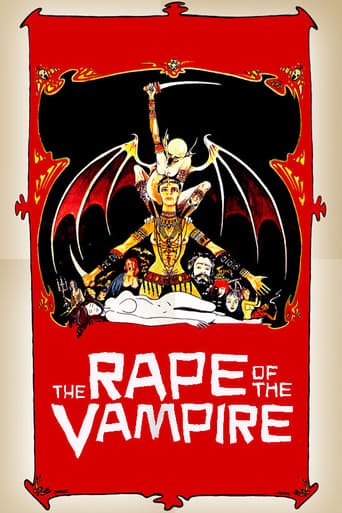jadavix
Jean Rollin's first full length movie, "The Rape of the Vampire", doesn't make a whole lot of sense, but it is visually interesting.It's shot in black and white, and has some interesting images:An old man is surrounded by female vampires in hooded cloaks. He tries to fight them off weakly with his walking stick, but fails.The queen of the vampires (I assume), a young black lady, has a string of blood run down her mouth in extreme close up travel in different directions, probably through running the footage backwards and forwards in alternate takes and then layering them.A guy who looks like one of the Oasis brothers driving his Triumph pick up truck up to another car, climbing out mid-drive and climbing onto the roof of the other car, gaining entrance for a little blood suckage.Not sure why it was called "The Rape of the Vampire". Couldn't remember any rape or even any sex. There are quite a few women walking around with breasts hanging out and wearing see through clothing, however.All up I would've preferred this movie to make sense. I like visually arresting images, but find it more powerful when these images are in service of a plot.
gavin6942
After a psychoanalyst unsuccessfully tries to convince four sisters that they are not 200 year old vampires, the Queen of the Vampires (Jacqueline Sieger) promulgates the cause of the Undead.Having watched Jean Rollin's "Nude Vampire" before this, I can say one thing: Rollin works better in black and white. His stark composition recalls some of Roman Polanski's better films (such as "Repulsion") and is just beautiful to look at. While the second half is completely incoherent if we focus on plot (which we should not do with Rollin), the film as a whole has images to show us that cannot be put down.A newspaper at the time of the film's release said "we can only remain puzzled by the intentions of the director, Jean Rollin." Even Rollin himself admitted that it was confusing. He would later say, "Le Viol was a terrible scandal... People were really mad when they saw it. In Pigalle, they threw things at the screen. The principal reason was that nobody could understand the story." But perhaps this is alright? When Luis Bunuel or Salvador Dali release nonsense, it is a work of art... when Rollin does it, we call it "nonsense". Where does one end and the other begin?
Mathis_Vogel
'The Rape of the Vampire' is split up into two parts. While the first segment is rather linear and 'normal', with super-expressive, daring camera angles, the second part, "La Reine Des Vampires" is a lot more confusing, while exhibiting the same level of visual excellence and dreamlike, naive atmosphere. The story is very fragmented and it's hard to follow the ever-multiplying characters. I find films like Franco's 'Succubus' or Jodorowsky's 'Holy Mountain' to be slow and pretentious, but I didn't have have any problem with the similarly haphazard and unstructured 'The Rape of the Vampire' doesn't feel artificial because it's got its heart in the right place, which can be said about majority of Rollin's films. He may not have professional actors, but he nevertheless gets them to deliver emotional performances and create moving, if not realistic, characters. The acting may be unpolished, but Rollin has a gift for drama which he displays more consistently then the other Eurotica directors(Franco, D'Amato) with whom he often gets bundled as a sexploitation director. The story is a mess, but a poetic one, and images are arresting. In terms of cinematography 'The Rape of the Vampire' is more more adventurous than director's more popular films 'Fascination' and 'La Morte Vivante'. I have the warmest feelings for this very brave film and will be re-watching it again.
salvador fortuny
An original, surreal and disturbing film that illustrates better than another movie Rollin's peculiar conception of cinema:a mixture of Gothic horror tale's imaginary , politic surrealism, dark romanticism, pulp comic book aesthetic and camera experimentalism. The film is conceived as a collage of images,inspired by the work of his favourite painter, Clovis Trouille, solution that allows him to blend much of the references of his ambiguous imaginary: the dreamy and dark romanticism poetry of Tristan Corbiere ,the sexy shocker surrealism of Georges Bataille, the thought-provoking and political cinema of Luis Buñuel, the pulp and bizarre style of Gaston Leroux and the poetic realism of Jacques Prevert.A non-narrative vampire tale: half romantic, half conceptual and totally experimental.


